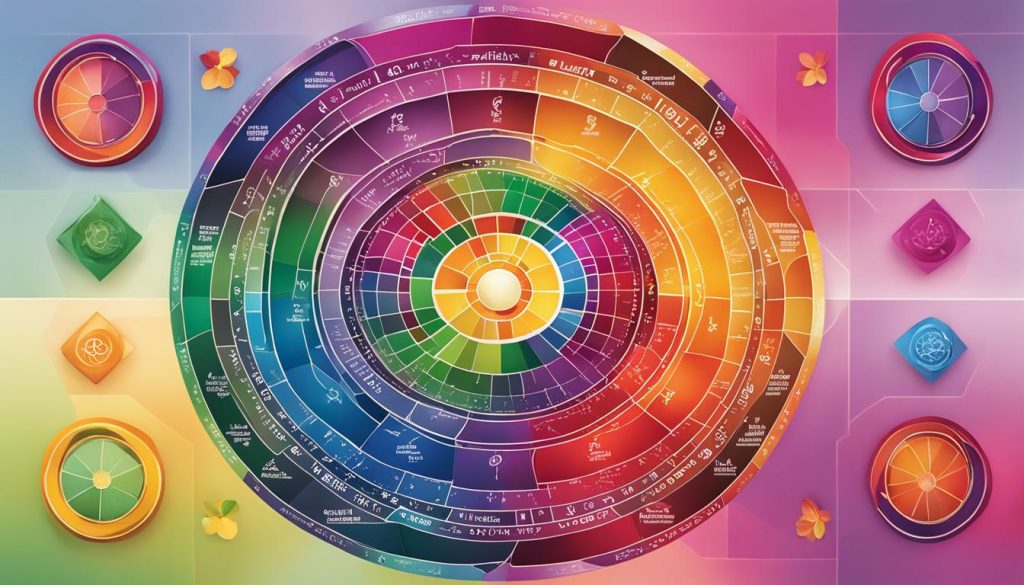Emotional strength is a crucial aspect of our lives, deeply intertwined with our resilience and overall well-being. It empowers us to navigate the ups and downs of relationships, fostering emotional intelligence and creating deeper connections. In this article, I will explore the Emotional Strength Spectrum, a comprehensive framework that sheds light on the intricate nature of emotional resilience and its impact on our lives.
Key Takeaways:
- The Emotional Strength Spectrum encompasses a range of emotions and experiences that contribute to resilient relationships.
- Understanding and developing emotional resilience is essential for enhanced emotional intelligence.
- The Emotional Strength Spectrum can help us navigate intense feelings and impulsive reactions.
- Identifying and understanding primary emotions is a stepping stone toward emotional regulation.
- Cultivating emotional strength can contribute to trust, intimacy, and overall relationship satisfaction.
What is Plutchik’s Wheel of Emotions?
Plutchik’s Wheel of Emotions, proposed by Dr. Robert Plutchik, is a visual representation of the eight primary emotions arranged in polar opposites. These emotions include joy, sadness, acceptance, disgust, fear, anger, and surprise and anticipation. The wheel provides a framework for understanding the relationships between these emotions and how they interact with each other.
The wheel consists of concentric circles, with the innermost circle representing the primary emotions and the outer circles representing their variations and intensities. This categorization allows individuals to identify and differentiate between different emotions and explore the nuances within each emotion category.
By using Plutchik’s Wheel of Emotions, individuals can better understand their own emotional experiences and how they relate to others. This tool can be particularly useful in therapy, counseling, and personal development, as it helps individuals recognize and regulate their emotions in a more effective and healthy way.

Understanding the Primary Emotions
Within Plutchik’s Wheel of Emotions, the eight primary emotions serve as the foundation for all other emotions. Each primary emotion has its own unique qualities and triggers, which can vary from person to person. By understanding and identifying these primary emotions, individuals can develop emotional intelligence and navigate their emotional landscape with greater ease.
| Primary Emotion | Description | Opposite Emotion |
|---|---|---|
| Joy | A feeling of happiness and contentment | Sadness |
| Acceptance | An emotion of embracing situations or people as they are | Disgust |
| Fear | An emotion triggered by perceived threats or danger | Anger |
| Surprise | A reaction to unexpected events or situations | Anticipation |
By recognizing these primary emotions within themselves and others, individuals can cultivate empathy, improve communication, and develop stronger and more resilient relationships.
How to Use Plutchik’s Wheel of Emotions
Plutchik’s Wheel of Emotions can be valuable for developing emotional intelligence and self-awareness. By utilizing this visual representation of primary emotions, individuals can navigate their own emotional experiences and respond effectively in various situations.
One way to use Plutchik’s Wheel of Emotions is for personal reflection. Take the time to identify which primary emotions resonate with you the most and explore the nuances of each emotion. This self-reflection can provide valuable insights into your own emotional landscape and help you understand how your emotions influence your thoughts and actions.
Therapists and coaches can also use the wheel in their practice. By guiding clients through the wheel, professionals can assist individuals in identifying and understanding their emotions, ultimately leading to increased self-awareness and emotional regulation. This process can be particularly beneficial for those looking to enhance their emotional intelligence and develop effective coping strategies.
| Primary Emotion | Description |
|---|---|
| Joy | A state of great happiness or delight |
| Sadness | A feeling of sorrow or unhappiness |
| Acceptance | A willingness to embrace reality or a situation |
| Disgust | A strong feeling of dislike or revulsion |
| Fear | An unpleasant emotion caused by perceived danger |
| Anger | A strong feeling of displeasure or hostility |
| Surprise | The feeling caused by something unexpected |
| Anticipation | A feeling of excitement or expectation about the future |
By incorporating the use of Plutchik’s Wheel of Emotions into personal growth and therapy, individuals can gain a deeper understanding of their own emotional experiences. This understanding can lead to greater self-awareness, improved emotional regulation, and enhanced overall well-being.
What is the Difference Between Plutchik’s Wheel of Emotions and the Geneva Emotion Wheel?
While both Plutchik’s Wheel of Emotions and the Geneva Emotion Wheel categorize emotions, they differ in their approach. Plutchik’s wheel focuses on the eight primary emotions and their relationships, while the Geneva Emotion Wheel categorizes emotions into five main dimensions: pleasure, arousal, dominance, certainty, and attention.
Plutchik’s Wheel of Emotions visually represents emotions and their polar opposites. It provides a clear understanding of the relationships between emotions, helping individuals identify and navigate their own feelings. Individuals can develop emotional intelligence and self-awareness by recognizing primary emotions like joy, sadness, anger, and fear.
In contrast, the Geneva Emotion Wheel takes a broader approach by categorizing emotions based on dimensions such as pleasure, arousal, dominance, certainty, and attention. This wheel allows for a more nuanced understanding of emotions and their varying intensities.
“Plutchik’s Wheel of Emotions helps individuals understand the core emotions and their interconnections, while the Geneva Emotion Wheel provides a multidimensional view of emotions, taking into account factors like pleasure and dominance.” – Dr. Emily Smith, Emotional Intelligence Expert
Both Plutchik’s Wheel of Emotions and the Geneva Emotion Wheel offer valuable frameworks for understanding and working with emotions. Whether focusing on the primary emotions or exploring dimensions like pleasure and arousal, these tools can be used for personal reflection, therapy, and coaching to enhance emotional understanding, regulation, and well-being.
| Plutchik’s Wheel of Emotions | Geneva Emotion Wheel |
|---|---|
| Focuses on eight primary emotions | Categorizes emotions into five main dimensions |
| Provides a visual representation of emotions and their relationships | Offers a multidimensional view of emotions based on pleasure, arousal, dominance, certainty, and attention |
| Explores the core emotions and their interconnections | Allows for a nuanced understanding of emotions and their varying intensities |
How to Use an Emotion Wheel in Counseling with Quenza
Using an emotion wheel in counseling sessions can be a powerful tool for both therapists and their clients. Quenza, a reputable platform, offers a range of emotion wheel worksheets and tools that can be incorporated into counseling sessions. These resources provide visual aids that can help clients identify and explore their emotions, ultimately leading to greater self-awareness and emotional regulation.
By using an emotion wheel, therapists can guide clients through the process of identifying specific emotions and understanding their underlying causes. This process can be particularly beneficial for individuals who struggle with emotional expression or have difficulty identifying their feelings. The emotion wheel provides a structured framework for exploring the complex range of emotions that individuals may experience.
In counseling sessions, therapists can encourage clients to use the emotion wheel to track their emotional states over time. This can help clients recognize emotional patterns, identify triggers, and develop strategies for managing emotional responses. By fostering emotional awareness and regulation, therapists can support clients in building resilience and coping skills.
Benefits of Using an Emotion Wheel in Counseling
- Enhanced emotional awareness and regulation
- Identification of emotional triggers and patterns
- Development of effective coping strategies
- Improved self-understanding and self-reflection
- Greater emotional resilience and well-being
Incorporating an emotion wheel into counseling sessions can effectively support clients in their journey toward emotional well-being. Quenza’s resources provide therapists with the tools they need to facilitate meaningful discussions and guide clients toward greater self-awareness and emotional growth.

Controlling Emotions Through Vertical Development
Vertical development can play a crucial role in emotional stability, stress management, and coping skills. Vertical development refers to the process of personal growth and maturity that enables individuals to control their emotions better, navigate challenges, and respond effectively to stressful situations. Individuals can cultivate greater emotional strength and resilience by intentionally investing in self-reflection, self-awareness, and intentional personal growth.
The Pillars of Vertical Development
- Self-reflection: Taking the time to introspect and understand one’s emotions, triggers, and patterns of behavior can lead to greater self-awareness and emotional regulation. It involves examining one’s thoughts, beliefs, and reactions to various situations, allowing for personal growth and transformation.
- Self-awareness: Understanding one’s emotions, strengths, limitations, and values is essential for developing emotional stability. Through self-awareness, individuals can better recognize and manage their emotions, make intentional choices, and navigate relationships more effectively.
- Intentional personal growth: Engaging in activities that promote personal growth, such as therapy, coaching, mindfulness practices, and self-care, can contribute to emotional stability and resilience. It involves consciously investing in one’s mental, emotional, and physical well-being to enhance overall life satisfaction.
Vertical development is an ongoing process that requires commitment, self-reflection, and practice. Individuals can build emotional strength, improve stress management, and enhance their coping skills by actively developing these pillars.
| Benefits of Vertical Development | Strategies for Vertical Development |
|---|---|
|
|
Vertical development is a powerful tool for individuals seeking to improve their emotional well-being and build resilience. By prioritizing self-reflection, self-awareness, and intentional personal growth, individuals can develop the skills and mindset necessary to control their emotions and navigate life’s challenges effectively.

A Fun Test Using Plutchik’s Wheel of Emotions: Who Are You Really According to the Emotion Wheel?
Plutchik’s Wheel of Emotions provides a fascinating framework for exploring and understanding our complex emotional landscape. If you’re curious about your dominant emotions and how they relate to others, you can take a self-assessment test using the Emotion Wheel. This fun test can offer insights into your emotional tendencies, helping you deepen your self-awareness and personal growth.
To take the test, start by familiarizing yourself with the eight primary emotions on Plutchik’s Wheel: joy, sadness, acceptance, disgust, fear, anger, surprise, and anticipation. Reflect on your experiences and feelings, and consider which emotions you resonate with most strongly. Then, imagine where those emotions fall on the Wheel, noting their relationships to each other.
Using this information, you can create your own personalized Emotion Wheel based on your dominant emotions. This personalized Wheel can visually represent your emotional landscape, showcasing the strengths and challenges you may face in navigating your emotions. It’s a valuable tool for self-reflection, self-discovery, and a deeper understanding of who you are emotionally.
| Emotion | Strengths | Challenges |
|---|---|---|
| Joy | Optimism, happiness, enthusiasm | Potential for naivety, overlooking negative aspects |
| Sadness | Emotional depth, empathy, introspection | Difficulty finding motivation, prolonged emotional states |
| Acceptance | Tolerance, open-mindedness, adaptability | Reluctance to change, difficulty setting boundaries |
| Disgust | Discernment, self-protection, boundary-setting | Excessive judgment, difficulty trusting others |
| Fear | Alertness, caution, self-preservation | Overwhelming anxiety, avoidance of risks |
| Anger | Assertiveness, boundary-setting, passion | Difficulty controlling anger, strained relationships |
| Surprise | Flexibility, adaptability, spontaneity | Discomfort with uncertainty, difficulty planning |
| Anticipation | Excitement, motivation, goal-setting | Impatience, disappointment when expectations aren’t met |
Remember, the Emotion Wheel is a tool for self-exploration rather than a strict personality assessment. It provides insights into your emotional tendencies but doesn’t define or limit who you are. Embracing the full spectrum of emotions and recognizing the complexity of human experience is a key aspect of emotional growth and resilience.

“The beauty of the Emotion Wheel lies in its ability to reveal the intricacies of human emotion. By engaging with this tool, we can deepen our self-awareness and gain valuable insights into our emotional landscape.” – Unknown
The Power of Emotional Strength in Relationships
Building emotional strength in relationships is crucial for fostering resilient connections and enabling shared growth. When we possess emotional strength, we are better equipped to navigate challenges, communicate effectively, and support our partners through the highs and lows of life. Emotional strength contributes to trust, intimacy, and overall relationship satisfaction.
Emotional strength allows us to embrace vulnerability and express our emotions openly, creating a safe space for both partners to be authentic and genuine. It enables us to understand and regulate our own emotions, leading to healthier communication and conflict resolution. When both partners possess emotional strength, they can navigate disagreements with empathy and respect, fostering a deeper understanding and connection.
Shared growth is an essential outcome of emotional strength in relationships. As we develop emotional resilience together, we embark on a personal and collective growth journey. We support each other’s aspirations, encourage one another’s dreams, and celebrate individual achievements. By fostering emotional strength, we create a solid foundation for a lifelong partnership filled with love, support, and mutual admiration.
The Impact of Emotional Strength on Relationships
Emotional strength in relationships creates a ripple effect that extends beyond the couple themselves. When partners are emotionally strong, they serve as role models for their children, friends, and broader social circle. Their ability to navigate challenges and communicate effectively becomes an inspiration for others, encouraging healthier dynamics and stronger connections.
Emotional strength also enables couples to weather storms together. Life inevitably presents us with ups and downs, and having emotional strength allows partners to provide each other with unwavering support during difficult times. They can lean on each other, offer reassurance, and find solace in their shared strength.
In conclusion, building emotional strength in relationships is a transformative process that fosters resilience, trust, and shared growth. It empowers couples to navigate challenges, communicate effectively, and create a safe and loving space for emotional expression. By cultivating emotional strength together, partners embark on a journey of personal and collective growth, creating a strong foundation for a fulfilling and lifelong partnership.

Enhancing Emotional Strength through Personal Development
Personal development plays a crucial role in enhancing emotional strength. Engaging in practices such as self-reflection, therapy, mindfulness, and self-care can contribute to emotional resilience, mental well-being, and overall emotional balance. Developing emotional intelligence and coping skills can also strengthen emotional health.
Self-reflection is a powerful tool for personal growth and emotional strength. Understanding our thoughts, emotions, and triggers allows us to gain insight into ourselves and make positive changes. Journaling, meditation, or simply setting aside quiet time for introspection can help us uncover patterns, beliefs, and behaviors that may be holding us back.
Therapy is another valuable resource for personal development. It provides a safe space to explore emotions, past traumas, and relationship dynamics. A trained therapist can guide us in developing healthy coping strategies, improving communication skills, and enhancing self-awareness. Through therapy, we can better understand ourselves and learn effective ways to navigate challenges.
Table: Techniques for Enhancing Emotional Strength
| Technique | Description |
|---|---|
| 1. Mindfulness | Cultivating present-moment awareness, reducing stress, and promoting emotional well-being. |
| 2. Self-care | Engaging in activities that nurture and nourish the mind, body, and soul. |
| 3. Therapy | Seeking professional guidance to explore emotions, traumas, and relationship dynamics. |
| 4. Coping Skills | Developing healthy ways to manage stress, regulate emotions, and navigate challenges. |
| 5. Emotional Intelligence | Enhancing self-awareness, empathy, and understanding of emotions in oneself and others. |
Mindfulness practices can also contribute to emotional strength. Mindfulness allows us to respond to challenging situations with clarity and composure by cultivating present-moment awareness and reducing stress. Regular meditation, deep breathing exercises, or mindful activities like yoga or walking in nature can help build resilience and promote emotional well-being.
Lastly, developing coping skills is essential for enhancing emotional strength. Learning healthy ways to manage stress, regulate emotions, and navigate challenges empowers us to maintain emotional balance. Coping strategies can include relaxation techniques, problem-solving skills, social support networks, or engaging in hobbies and activities that bring joy and fulfillment.
Through personal development practices such as self-reflection, therapy, mindfulness, and developing coping skills, we can enhance our emotional resilience, promote mental well-being, and cultivate a balanced and fulfilling life.
Strategies for Building Emotional Strength and Resilience
Building emotional strength and resilience is crucial for navigating life’s challenges and maintaining overall well-being. By developing coping skills and implementing effective stress management techniques, you can enhance your emotional resilience and thrive in the face of adversity.
1. Practice Self-Care
Self-care is essential for nurturing emotional strength and resilience. Make time for activities that bring you joy and relaxation, such as engaging in hobbies, spending time in nature, or practicing mindfulness and meditation. Taking care of your physical health through exercise, proper nutrition, and adequate sleep also contributes to emotional well-being.
2. Set Boundaries
Setting boundaries is an important aspect of building emotional strength. Clearly communicate your needs, values, and limits to others, and prioritize your own well-being. Learning to say no when necessary and surrounding yourself with positive, supportive relationships can help protect your emotional energy and prevent burnout.
3. Develop Healthy Coping Skills
Healthy coping skills are essential for effectively managing stress and building emotional resilience. Find healthy outlets for your emotions, such as journaling, creative expression, or talking to a trusted friend or therapist. Practice relaxation techniques, such as deep breathing exercises or progressive muscle relaxation, to help reduce stress levels and promote emotional balance.
4. Seek Support from Loved Ones
Building emotional strength doesn’t mean you have to do it alone. Reach out to loved ones for support and connection. Having a strong support system can provide a sense of belonging, validation, and comfort during difficult times. Allow yourself to lean on others and ask for help when needed.
You can cultivate emotional strength and resilience by incorporating these strategies into your daily life. Remember that building emotional strength is a journey that takes time and practice. Be patient with yourself, celebrate your progress, and continue to prioritize your emotional well-being.

The Role of Emotional Balance in Daily Life
Emotional balance is a fundamental aspect of our daily lives, affecting our overall well-being and stress management. It encompasses recognizing and acknowledging our emotions, understanding their triggers, and finding healthy ways to express and regulate them. Developing emotional balance is crucial for maintaining mental and emotional health, improving relationships, and making sound decisions.
When we achieve emotional balance, we become more self-aware, understanding our own emotional states and how they influence our thoughts and behaviors. This self-awareness allows us to navigate life’s challenges with greater resilience and clarity. By staying attuned to our emotions, we can respond to situations more accurately and thoughtfully rather than reacting impulsively.
One effective strategy for developing emotional balance is through mindfulness practices. Mindfulness involves paying deliberate attention to the present moment without judgment. It allows us to observe our emotions as they arise, giving us the space to choose how we respond to them. Practicing mindfulness regularly can cultivate a greater sense of calm and equanimity, even in the face of stress or adversity.
Another important aspect of emotional balance is seeking support and engaging in self-care. Building a strong support system of friends, family, or mental health professionals can provide a safe space to express our emotions and gain valuable insights. Additionally, engaging in self-care activities that promote relaxation, such as exercise, hobbies, or spending time in nature, can help restore emotional balance and reduce stress.
Ultimately, cultivating emotional balance requires ongoing effort and self-reflection. It is an ongoing journey of personal growth and self-discovery. We can lead more fulfilling and resilient lives by prioritizing emotional well-being and taking proactive steps toward achieving balance.

| Benefits of Emotional Balance | Strategies for Cultivating Emotional Balance |
|---|---|
|
|
Conclusion
In conclusion, understanding and developing emotional strength is crucial for resilient relationships and personal growth. The Emotional Strength Spectrum encompasses a wide range of emotions and experiences that shape our interactions and well-being. Utilizing tools like Plutchik’s Wheel of Emotions and practicing personal development strategies can cultivate emotional resilience and balance for a more fulfilling life.
Plutchik’s Wheel of Emotions visually represents the primary emotions and their relationships, serving as a valuable tool for self-awareness and emotional intelligence. By identifying and understanding these emotions, we can navigate our own feelings and better respond to others in various situations.
Personal development plays a vital role in enhancing emotional strength. Engaging in practices such as self-reflection, therapy, mindfulness, and self-care contributes to emotional resilience and mental well-being. Building emotional strength and resilience involves developing healthy coping skills, setting boundaries, seeking support, and engaging in activities that promote emotional well-being.
We can improve our relationships, decision-making, and overall well-being by cultivating emotional strength and balance. Embracing the Emotional Strength Spectrum and integrating its principles into our lives allows us to thrive and experience more fulfilling connections with ourselves and others.
FAQ
What is Plutchik’s Wheel of Emotions?
Plutchik’s Wheel of Emotions is a visual representation of eight primary emotions arranged in polar opposites. These emotions include joy and sadness, acceptance and disgust, fear and anger, and surprise and anticipation.
How to Use Plutchik’s Wheel of Emotions?
Plutchik’s Wheel of Emotions can be used for personal reflection, therapy, and coaching. By identifying and understanding the primary emotions, individuals can better navigate their own emotions and respond appropriately in various situations.
What is the Difference Between Plutchik’s Wheel of Emotions and the Geneva Emotion Wheel?
While both wheels categorize emotions, they differ in their approach. Plutchik’s wheel focuses on the eight primary emotions and their relationships, while the Geneva Emotion Wheel categorizes emotions into five main dimensions: pleasure, arousal, dominance, certainty, and attention.
How to Use an Emotion Wheel in Counseling with Quenza?
Quenza offers emotion wheel worksheets and tools for counselors to incorporate into their counseling sessions. The emotion wheel can be used as a visual aid to help clients identify and explore their emotions, supporting emotional awareness, regulation, and coping skills.
What is Vertical Development?
Vertical development refers to the process of personal growth and maturity that enables individuals to better control their emotions. Developing emotional stability, stress management techniques, and effective coping skills can contribute to greater emotional strength and resilience.
How can I take a self-assessment test using Plutchik’s Wheel of Emotions?
Taking a self-assessment test using Plutchik’s Wheel of Emotions can help individuals gain insights into their dominant emotions and how they relate to others. It can be a helpful tool for self-reflection, self-discovery, and personal growth.
How can emotional strength enhance relationships?
Emotional strength allows partners to navigate challenges, communicate effectively, and support each other through emotional ups and downs. It contributes to trust, intimacy, and overall relationship satisfaction.
How can personal development enhance emotional strength?
Engaging in practices such as self-reflection, therapy, mindfulness, and self-care can contribute to emotional resilience, mental well-being, and overall emotional balance. Developing emotional intelligence and coping skills can also strengthen emotional health.
What are some strategies for building emotional strength and resilience?
Strategies for building emotional strength and resilience include practicing self-care, setting boundaries, developing healthy coping skills, seeking support from loved ones, and engaging in activities that promote emotional well-being. Mindfulness, relaxation techniques, and stress management tools can also be helpful.
Why is emotional balance important?
Emotional balance is essential for managing daily life and reducing stress. Cultivating emotional balance can improve relationships, decision-making, and overall well-being by recognizing, understanding, and regulating our emotions in healthy ways.
How can I develop emotional strength for a more fulfilling life?
Understanding and developing emotional strength through tools like Plutchik’s Wheel of Emotions and personal development strategies can enhance relationships, mental well-being, and overall life satisfaction. It involves cultivating emotional resilience, self-awareness, and intentional personal growth.

